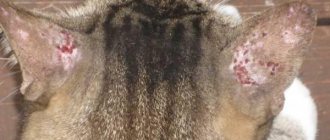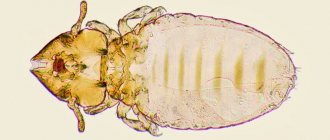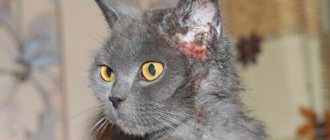Timely destruction of fleas will help avoid trouble for humans from constantly itchy flea bites. There are frequent cases of allergic dermatitis in a person or pet, leading to the appearance of pustules and hair loss in the bitten area. One bite of a flea, an insect parasitizing rodents, cats or dogs, can cause the following disease:
- plague
- typhus,
- hepatitis,
- tularemia,
- encephalitis and other deadly infections.
Even the transfer of tapeworms from host to host is often carried out by these “bloodsuckers”.
How a flea bites
A person experiences a sharp stabbing pain when bitten by a flea, this is explained by the fact that, unlike bedbugs and ticks, the flea does not inject an anesthetic at the time of its bite. Thanks to special enzymes that block blood clotting, which the flea injects during a bite, human blood flows through the wound into the flea's stomach in a thin stream almost by itself. When the flea detaches itself from the bite, the elastic walls of the skin will close and prevent bleeding from escaping.
A painful bite is the least of the evils that a flea can cause.
Where do fleas come from in cats?
As it turns out, it is simply a myth that an indoor cat that does not leave the apartment and does not walk with outdoor cats cannot become infected with fleas. These parasites, in search of a victim, are quite capable of moving long distances on their own, even feeding on raids, without using an animal. Therefore, it can be difficult for owners to detect whether a cat has fleas.
The main causes of fleas in cats:
- from another infected animal;
- from you, you could bring a flea from the street on your own clothes;
- from a neighbor’s apartment or basement if you live in an old house or the neighbors do not process their animals;
- from your dog (yes, fleas are also transmitted from dogs to cats) who picked up a flea on the street.
– Fleas in animals are a very relevant topic, since most dermatological patients suffer precisely because of this problem. In veterinary medicine there is such a disease as atopic flea dermatitis - an allergy to flea saliva (2). It occurs in many patients and manifests itself as dermatitis and itching. This is also a problem because many owners believe that there cannot be fleas in their apartment or on their animal. Unfortunately, we do not live in sterile conditions and in residential buildings, especially if they are not new, fleas can live in basements, be in baseboards, or simply get from the entrance to the apartment. Both a walking animal and a completely domestic animal can become infected,” says veterinarian Marina Mikheenko.
Symptoms of fleas in cats
You can tell if your cat has fleas by the following symptoms:
- the cat began to itch frequently and for a long time;
- small wounds covered with a crust appeared on the cat’s skin;
- the cat began to sleep restlessly: what is called to scratch itself, jumps up in its sleep;
- the cat's appetite has decreased;
- When examining the fur, you can notice black dots - flea excrement, and you can also notice the insects themselves, which quickly move inside the hairs.
When fleas get on a cat's fur, they bite through its skin to feed on blood. This causes pain to the animal, flea bites itch, so the cat can not only scratch them vigorously, but also introduce an infection, turning the wounds into purulent abscesses. But the worst thing is that fleas are carriers of dangerous infections that can be fatal to cats. And the sooner you find fleas on your cat, the easier it will be to remove these dangerous parasites. By the way, although fleas do not live on people, they can bite them, so the owners are also at risk.
Consequences of a flea bite
- An allergic reaction to an enzyme that prevents blood clotting can vary. From rashes, itching, redness and swelling to anaphylactic shock
- The flea is a carrier of a huge number of dangerous diseases.
- Itching caused by a flea bite forces a person to scratch the wound, thereby creating the risk of contracting secondary infections.
Diseases whose pathogens are transmitted by parasites themselves pose a huge danger. Their specificity is largely determined by the type of blood-sucking insect.
Popular questions and answers
We discussed the most pressing questions that cat owners ask about fleas with veterinarians.
Why are fleas dangerous?
– Fleas can cause not only an allergic reaction, but also severe anemia in weakened and young animals with severe infestation. They are also carriers of helminthic and infectious infestations, such as feline hemobartonellosis,” says veterinarian Marina Mikheenko.
How to check if a flea treatment will cause an allergy in a cat?
“If you decide to use a spray, first spray it on a small area of fur and wait a few hours,” advises veterinarian Lyubov Bogdan. – If the product does not cause an allergic reaction, it can be used. But most often, allergies occur to collars, however, it is difficult to test them. They are selected only empirically.
What to do if your cat's fleas don't go away?
“This happens in rare cases; most likely, the instructions for using the flea remedy were violated or the drug was expired,” says veterinarian Lyubov Bogdan. – But if the fleas really don’t come out, you need to combine treatment. For example, add tablets to the collar, or combine a spray with injections. But it is better to contact a veterinarian so that he can prescribe the appropriate treatment.
Is it necessary to treat the apartment where the cat lives?
“Yes, it is necessary, because flea eggs may remain,” explains veterinarian Lyubov Bogdan. – Thorough cleaning and disinfection of the premises must be carried out simultaneously with treating the cat with flea products. Before disinfection, it is necessary to carry out general cleaning: wash everything that can be done at a temperature above 60 ° C and then iron. And treat the apartment itself with flea repellent.
Is it possible to treat a pregnant or lactating cat for fleas on your own?
– Pregnant and lactating cats can be treated for fleas with Frontline (the safest) and Stronghold sprays, Bravecto drops and Brondline spot on (the latter only under the supervision of a veterinarian). But it’s better to see a doctor,” recommends veterinarian Marina Mikheenko.
Are there differences between fleas in cats and kittens?
– The difference between flea infestation in cats and kittens is only that kittens may experience more serious consequences with severe flea infestation. In addition, not all drugs are suitable for kittens; it is important to read the instructions before use, explains veterinarian Marina Mikheenko.
Sources
- Lyutikova I.A., Arkhipov I.A. Methodological recommendations for the treatment and prevention of ctenocephalidosis in dogs and cats // Russian Journal of Parasitology, 2008 https://cyberleninka.ru/article/n/metodicheskie-rekomendatsii-po-terapii-i-profilaktike-ktenotsefalidoza-sobak-i-koshek
- Glazunova L.A., Tkacheva Yu.A. Comparative effectiveness of drugs for flea infestation in dogs and cats // Veterinary Doctor, 2017 https://cyberleninka.ru/article/n/sravnitelnaya-effektivnost-preparatov-pri-bloshinoy-invazii-sobak-i-koshek
What does a flea bite look like? photo
These fleas usually live in the habitats of rodents and birds; they are capable of not only biting skin and drinking blood, but also settle under the nails and lay eggs there. The larvae grow in this environment, feeding on the resulting pus and surrounding tissue. Itching, swelling, and irritation appear at the site of the lesion. Doctors diagnose sarcopsillosis.
Diagnosis of the appearance of dermatitis
The owner can independently determine the presence of fleas in a pet by changing behavior and examining its fur. But only a veterinarian can make an accurate diagnosis - an allergy to parasites - based on the results of laboratory tests and examination of the animal. To clarify the primary diagnosis, a sample is taken from the affected area of the skin and examined. In addition, an allergen test is prescribed.
Allergic dermatitis as a negative reaction to a large number of fleas has similar symptoms to a number of other diseases. Therefore, differential diagnosis is required. Allergy to parasites must be distinguished from diseases such as lice, sarcoptic mange, alopecia, and pemphigus foliaceus.
Dermatitis is a skin reaction that is a symptom and not a disease itself.
Flea bite symptoms
If the listed symptoms are well expressed, supplemented by profuse rashes in the area of the bites, their suppuration, ulcers in the mouth and throat, enlarged lymph nodes, fever and headache, insomnia, we can talk about the presence of a disease such as pulicosis, which is understood as a dermatological disease caused exclusively flea bites. This disease is usually caused by human fleas.
- Stitching sharp pain at the moment of the bite.
- Itching from a flea bite, more pronounced than from a mosquito bite.
- Formation of small tumors.
- The location of the bites is on the legs and occasionally in other places.
- A series of bites characteristic of these parasites.
Preventing fleas in cats
Prevention of fleas in cats is quite simple. It is necessary to observe basic rules of hygiene in the home and with the animal, namely:
- carry out anti-flea treatment of the animal in accordance with the cycle of the drug used (some drops are applied once every 2 months, and some once every six months);
- carry out unsanitary treatment of the apartment from parasites (bugs and fleas);
- at least once a year, bring the animal for a medical examination to the clinic so that the doctor can detect the presence of fleas in time by passing a simple test (more about it below);
- do not let the animal walk on its own (not only fleas are dangerous, but also stray dogs and cats themselves).
A cat can also pick up fleas from a dog.
Photo: pixabay.com If your pet suspects a flea infestation, the doctor may suggest a test with tape or wet paper, when a large number of black “dots” - “flea feces” are released from the fur; this is done when the fleas themselves are visible. the body is not visible (they can run in, bite, but not live on the animal).
If fleas do not cause concern, then for prevention purposes, monthly drops are used on the withers. Please note that they should be selected taking into account the weight of your pet. Such preparations are applied to the neck area, spreading the fur, squeezing out the entire pipette; it is not allowed to bathe the animal for several days after treatment.
In case of severe flea infestation or flea atopic dermatitis, it is recommended not only to treat pets with local products, but also to treat the apartment, beds, entrances, and basements.
For treating premises, there are products based on permethrin, for example: Cypermethrin, Parastop, you can also use Neostomazan, Butox.
– The room must be treated without cats: treat it and close the room for several hours. I recommend that you carefully read the instructions for all medications. Upholstered furniture can be treated with FLI spray. And you definitely need to vacuum more often. It’s better to replace the beds with new ones, recommends veterinarian Marina Mikheenko.
Vaccination. For cats with access to the outdoors, flea vaccination is a very effective way to prevent infection. It is enough to get vaccinated once a year, in spring or summer, so that you don’t have to worry about your pet’s health all year round. Preventive vaccinations are given in veterinary clinics; first you need to discuss the cat’s health status with your doctor, check it for possible pregnancy, and clarify at what age kittens are recommended to be vaccinated.
Collar. A collar soaked in herbal infusions or essential oils is an excellent way to prevent fleas in cats, especially animals that spend almost no time outside. The pungent odor repels parasites, and the plant composition of the impregnation is non-toxic for kittens, nursing mothers and pregnant cats.
Combined protection. If your cat often walks outside, then combined protection will help her avoid becoming infected with fleas - a collar soaked in herbal preparations, herbal drops on the withers and an anti-flea spray based on herbal ingredients. The complex of drugs will certainly repel parasites, and the herbal composition is suitable for almost all animals: kittens, elderly, pregnant and lactating animals.
Prevention of feline dermatitis
In order to prevent the formation of flea allergies in cats, as well as dermatitis and other complications, the pet owner performs the following actions :
- does not let the cat outside if it has a flea allergy;
- Do not walk your pet in places where there is high air humidity. After all, it is in such areas that fleas live for a very long time;
- treats cat fur with specific anti-flea drugs once every 1 month. Moreover, such products cannot be used if they have already expired;
- puts a flea collar or a special flea collar on the pet;
- regularly examines the pet - checks for the presence of various types of fleas on the cat;
- more often treats the entire space in the corridor near the front door with specific long-acting products;
- carries out wet, thorough cleaning and treats carpets with insecticidal agents against fleas;
- If allergic feline dermatitis develops, take your pet to an appointment with the attending veterinarian.
If the pet's condition does not improve, then it should be immediately shown to the attending physician. In such a situation, the veterinarian takes a skin scraping from the infected animal and prescribes the necessary anti-flea medication from it.
Moreover, pet owners should not use anti-flea medications on their own without first visiting a veterinarian. After all, some of them lead to possible side effects.
In addition, if you do not go to the veterinarian in a timely manner, the flea allergy becomes chronic, or the cat develops dangerous complications, which often lead to its death. This also should not be allowed.
Treatment regimens for cat allergies
Ridding an animal of parasites is not a sufficient measure to treat allergies. Depending on the symptomatic picture and the presence or absence of complications, appropriate drug therapy is selected.
Symptomatic therapy
For symptomatic treatment, drugs mainly from the hormonal pharmacological group are used:
- Prednisolone. The dosage ranges from 0.5 to 1 mg for every 1 kg of animal body weight. Prednisolone is used in tablet form.
- Dexaforte. The amount of the drug is 0.05 ml per 1 kg of weight. Dexaforte is used to treat animals that have excessive aggression due to allergies, and pets that spend a lot of time outdoors, where the risk of re-infection is high.
In addition, it is recommended to give antihistamines such as Tavegil, Zyrtec and Suprastin.
Prednisolone is a white or white with a slight yellowish tint crystalline powder in odorless tablets.
If a cat has constant access to the street, despite the treatment, she has a risk of re-infection with fleas and developing allergies. To avoid this, veterinarians recommend immunotherapy – introducing a small amount of an allergen into the animal’s body.
When a small amount of an irritating substance is constantly introduced into the body, the cat’s immune system begins to actively produce antibodies. Over time, their concentration increases, and the body ceases to be sensitive to the allergen.
Immune therapy in cats in 85% of cases gives a positive result, which consists in the complete elimination of allergies, even in the presence of fleas in the fur.
Antibiotics for severe cases
Antibacterial drugs are prescribed if the cat, due to an allergic reaction and severe scratching, has inflammatory processes (purulent) on the skin, and an infection has entered the wounds.
Antibiotics are substances that inhibit the growth of living cells, most often prokaryotic or protozoan.
Antibiotics for cats can only be prescribed by a veterinarian. Drugs with a wide spectrum of effects are used. The duration of the course is 14 days.
Skin restoration products
Allergies primarily negatively affect the condition of the coat: it loses its shine and strength, and actively falls out. Bald spots appear on it. Treatment of the pathological condition includes careful and proper care of the coat. To quickly return it to its normal state, special vitamin and mineral supplements are used.
They should contain fatty acids:
- Nordic Omega-3 Naturals;
- Medizinal Dorschlebertranl.
Additionally, special drops for wool are prescribed: Essential-6 or Allerderm.
If the owner feeds the cat with finished industrial products, it should be replaced with dry food, which contains all the elements necessary for hair restoration. Recommended foods with medicinal effects: Derma ProPlan Plus, Hill's z/d, Coat Formula and Royal Canin Skin.











